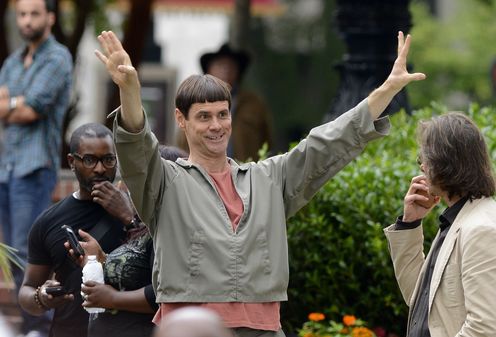
Comedian Jim Carrey flew his anti-vaccination colours on Twitter last week, railing against new Californian laws designed to reduce the number of unvaccinated children in public schools.
Along the way, Carrey has provided some excellent examples of the tactics used by online cranks, such as emotional escalation, errors of omission, dismissing experts and proclaiming to support science while simultaneously undermining it.
It is by teasing out these crank tactics that we can see Carrey’s tweets for what they are: well-intentioned but misguided attacks against a lifesaving practice that has been proven time and again to be safe and effective according to our very best scientific practices.
Emotional escalation
Carrey’s tweets are notable for his use of CAPSLOCK, the typed equivalent of shouting.
Emotional escalation, including yelling and insults, tend to polarise debates. Uncivil comments can also adversely impact how people interpret facts they have previously read.
Carrey’s anti-vaccination tweets also included photos of autistic boys, further escalating emotions. We feel sympathy for the boys and their families, but this is a poor substitute for statistical studies, which haven’t found any connection between vaccines and autism.
Carrey’s use of photos of autistic boys may also have backfired. One photo showed Alex Echols, who suffers from Tuberous Sclerosis, a genetic disorder often leads to autism. Echols’ autism has nothing to do with vaccines, yet he was initially used to emotionally bolster Carrey’s arguments (Carrey has since apologised).
Mercury matters
Ideas touted by cranks are often superficially true, yet misleading. A splendid example is:
This contains an error of omission, as it actually refers to two different mercury containing compounds. Methylmercury accumulates in animals and is dangerous when ingested. Thimerosal was once a common preservative in vaccines, and breaks down into ethylmercury, which is rapidly removed from the body.
Does Carrey’s tweet “make sense?” No.
I’m pro-science
Historian of science Michael Gordin succinctly notes:
No one in the history of the world has ever self-identified as a pseudoscientist. There is no person who wakes up in the morning and thinks to himself, “I’ll just head into my pseudolaboratory and perform some pseudoexperiments to try to confirm my pseudotheories with pseudofacts.”
Cranks often proclaim their love of science while simultaneously attacking it. Carrey tweeted:
Carrey claims to be pro-vaccine while credulously repeating dangerous myths about their risks. He lacks expertise to evaluate studies of the efficacy and risks of vaccines (which often use similar scientific techniques), but has reached strong yet contrary opinions on these topics. How can this be reasonable?
The tactic of proclaiming support for science while simultaneously undermining it isn’t restricted to comedians. The Australian newspaper has claimed it “supports global action on climate change based on the science,” but often repeats stories sourced from the internet that reject peer-reviewed climate science.
Dismissing experts
So how does Carrey dismiss the work of thousands of medical researchers from around the globe? Very easily. Like many internet cranks, he makes unfounded accusations of scientific organisations being corrupt:
This is a very common tactic for dismissing broad swathes of evidence. Some climate contrarians believe scientists are engaged in criminal activity:
Such claims get into conspiracy theory territory, particularly as independent groups of scientists scattered across the globe get comparable results. For example, the American Berkeley Earth team – which started off sympathetic to climate change sceptics – finds very similar temperature rise across Australia as Bureau of Meteorology scientists.
Even sympathetic media generally tone down bloggers’ claims of criminal activity. That said, it is curious that innocent activities such as data processing and analysis are sometimes referred to as (more ominous sounding) data manipulation. A less severe variant of the corruption tactic is claiming experts have a conflict of interest, as they are paid to undertake their work. Of course, this allows one to dismiss evidence from almost any professional – be that a doctor, lawyer, psychologist or scientist – leaving only courageous internet amateurs.
Popularity
Why is anyone paying attention to Carrey when it comes to vaccines? The answer is celebrity. He is a successful actor, with almost 15 million followers on Twitter. If he says something controversial, millions of people immediately know about it.
Crank ideas, which have been rejected by the scientific community, only remain alive while they have support from the public, celebrities, millionaires or politicians. Without popularity, crank ideas wither and die.
Cranks and their supporters know they must remain popular to survive, and game the system. Cranks often badge themselves as “coalitions”, “institutes”, “networks” and “alliances.” Cranks can buy social media followers or use “follow back” accounts to give the appearance of significant support. Websites often contain myriad links to fellow cranks, which may be an attempt to game search engine rankings. So cranks may appear more significant to the public and media than they truly are.
Of course, to have celebrity support is incredibly helpful to cranks. Along with Carrey, Bill Maher, Robert F Kennedy Jr. and Jenny McCarthy have promoted the anti-vaccination cause. They have helped keep this cause alive, even though it’s at odds with medical research.
Carrey almost certainly means well. But, like many internet cranks, he doesn’t have the expertise to distinguish scientific fact from dangerous myth. The recent death of a woman from measles and the Disneyland measles outbreak highlight just how dangerous such myths can be.
Michael will be on hand for an Author Q&A between 10:30 and 11:30am AEST on Tuesday, July 7. Post your questions in the comments section below.
Michael J. I. Brown receives research funding from the Australian Research Council and Monash University, and has developed space-related titles for Monash University’s MWorld educational app.
Geraint Lewis receives funding from the Australian Research Council, including a Future Fellowship.
